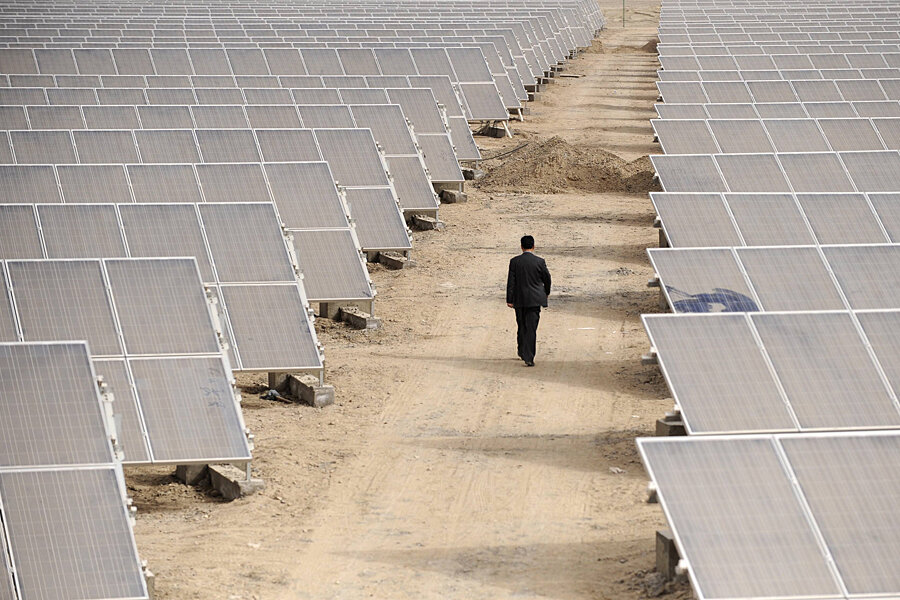In race for solar power, China is winning
Loading...
China is the world’s top energy consumer, with the vast majority of its electricity coming from domestically-mined coal. But the Asian nation is cutting its dependence on coal, oil and natural gas and replacing it with solar at a breakneck pace.
Between January and the end of June, China added 3.3 gigawatts of solar capacity, double the additions over the same period last year, and equivalent to the entire solar capacity of Australia – one of the sunniest places on earth. That brings China’s total solar power supply up to 23 gigawatts, second only to Germany’s 36 GW, and just 13 GW shy of the country’s goal of having 35 GW of solar installed by 2015.
The main reason, of course, is environmental. Choking clouds of pollution from vehicles and fossil-fueled power plants are the norm for residents of many Chinese cities, and the situation is only getting worse. Earlier this month, the Chinese government announced that it would ban the use of coal in Beijing by the end of 2020--although coal power use outside the capital is expected to continue.
Solar shift from Europe to Asia
Germany used to be the undisputed solar champion. And while the country is still a leader in solar power generation, it is being surpassed by China and to a lesser extent, Japan, which embraced solar-powered electricity after the Fukushima nuclear power plant meltdown in 2011. That event forced Japan to shut down all of its nuclear reactors, and look to other sources to meet its electricity needs.
According to a 2014 report by Hanergy Holding Group, China installed 12 GW of new photovoltaic (PV) generation capacity in 2013, a massive 232 percent increase over the previous year. Compare that to Germany, whose new PV capacity dropped 56.5 percent, and Italy, where new solar power additions fell by 55 percent.
The report also notes that China in 2013 accounted for the largest proportion of global solar industry financing, at $23.5 billion, equivalent to the entire amount raised in Europe.
The shift from Europe to Asia has to do with how China incentivizes solar power compared to its competitors, along with the sheer size of the Chinese solar panel manufacturing industry, which dominates the market for solar PV construction.
China’s solar dumping
As China ramped up its PV cell production to meet solar targets, global prices fell, leading to a shakeout of uncompetitive solar panel manufacturers. Clean Technica reports that over the past three years, PV system costs have fallen by over 50 percent, while the number of suppliers has declined from 250 in 2010 to 150 in 2013.
European and American PV cell makers complained that China was selling its solar panels on the world market below cost, putting domestic panel-makers out of business. In 2012, the U.S. imposed antidumping tariffs on Chinese solar panels. The European Union later threatened to do the same, but the confrontation was headed off when the EU and China came to an agreement over minimum panel prices. (Related article: A U.S-China War over Solar Power)
How China incents solar
Undercutting the competition is not the only reason China has the edge when it comes to solar power growth. While Germany and the rest of Europe have scaled back government incentives to install solar, in China, increased targets for solar power generation have been backed by programs to boost market demand. A feed-in tariff passed last year amounts to a subsidy of between 14 and 16 U.S. cents per kilowatt hour, and applies to both ground-mounted and rooftop panels. Feed-in tariffs incent renewable energy producers by allowing them to charge a higher price for their electricity than the retail rate.
New public buildings, along with public infrastructure such as railway stations and airport terminals, will be eligible for subsidies under the country’s goal of installing eight GW of distributed solar, which refers to electricity produced near to where it’s used. The subsidies are expected to spur orders for solar equipment. The Chinese government is encouraging financial institutions to offer discounts on loans and is encouraging the formation of PV industry investment funds among insurance companies and trusts, Bloomberg reported this month.
China’s solar competitors have also implemented government incentives, but not as effectively. Following Fukushima, Japan rolled out a feed-in tariff equal to 37 U.S. cents, twice that of Germany and France, with the goal of producing up to 17 GW of solar capacity. But over the past two years, the ministry cut the tariffs by a fifth and imposed time limits on installations, leaving only 13 percent of approved projects actually installed and operating, Reuters reported.
The United States offers a federal tax credit for residential solar-powered systems, and, depending on the state, a system of tax credits, rebates administered by state agencies or utilities, and performance-based incentives based on kilowatt-hour production. In 2013, the U.S. set a new record for new installed PV capacity -- 4,751 MW. But according to a recent study, complex permitting regulations are inhibiting the growth of solar in the United States, with one in three installers avoiding selling solar in certain cities due to difficulties obtaining permits.
There is no doubt that China’s push to increase solar power is being driven by an acute and pressing national problem – air pollution. Solar offers a way out of the competing pressures China is under to fuel economic growth and also arrest deteriorating air quality. But the Chinese government has also been smart in the way it has incented private industry to build out solar power capacity. As long as China’s solar competitors do not have the same environmental imperative, they will likely continue to lag behind China in new solar power additions. For that reason, the solar growth story is likely to be centered in China, at least for the foreseeable future.







